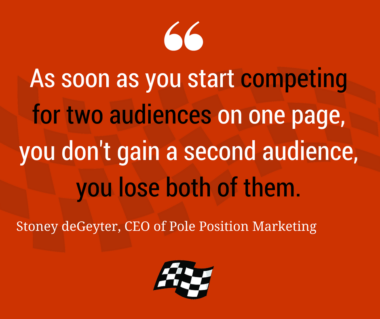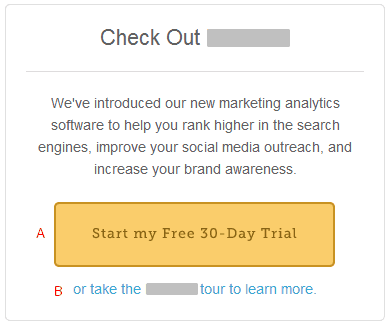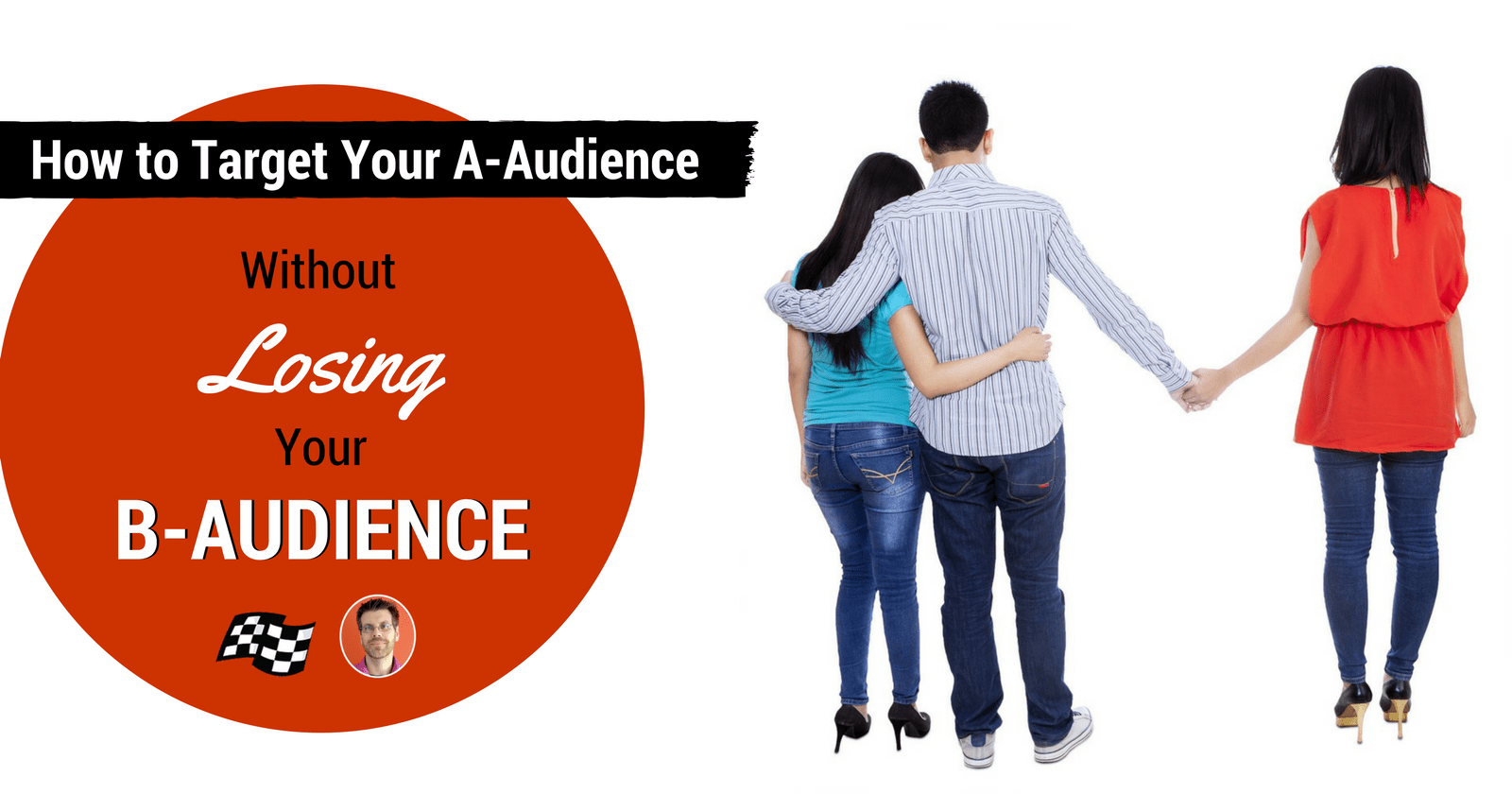Years ago, I was talking with a guy about his girlfriends. Yes, that was plural.
You see, this friend had an A-Girl, a B-Girl and a C-Girl. If you’re wondering how he kept them all straight, he had a system for that:
- C-Girl knew she was C-Girl, which means she also knew there was both an A-Girl and B-Girl.
- B-Girl knew she was B-Girl which means she also knew there was an A-Girl. But if she ever found out that there was a C-Girl, there would be trouble.
- A-Girl thought she was the girl and could never, ever find out about B-Girl or C-Girl.
Now, if you ask me, that seems backward because he was less honest with the girl that he liked most (A-Girl) than he was with the other two who were more expendable. But hey, nobody’s asking me.
I have no idea how this worked out for him, but it works as a good analogy for your website’s audience.
Let’s face it, when it comes to targeting your audience you have your A-, B-, and C-girls (or guys).
Your audience A-Girl is comprised of people who are most likely to buy your product or services. Your B-Girl audience might be comprised of those who are might become interested, and your C-Girls are those who are interested enough in your topic to learn more about it but aren’t really shopping.
The tricky thing is you have to have content for each of those audiences.
Marketing to Your A- Audience
Everything you do on your site must provide value for your A-Audience. This is your primary audience. Therefore, you must treat her with the respect she deserves. When you get your site dressed up, A-Audience needs to know it’s for her. Navigation, calls-to-action, and your content must have your A-Audience in mind first and foremost.
Unlike the guy above, however, it’s OK for your A-Audience to know about your B- and C-Audiences. However, anything you do for those audiences must be secondary and not impede the A-Audience journey through your site.
When it comes to making decisions about your website, what to write, what images to use, etc., those decisions should be based on what your A-Audience would love.
In fact, A-Audience’s opinions matter a lot more than anyone else’s – more than the boss, more than the development team designing the site, and even more than what your SEO wants to do. And yes, even more than B- and C- Audience.
If it doesn’t work for the A-Audience, then it doesn’t go on the site.
Does that mean you can’t do anything to benefit B- and C-Audiences? Not at all. You can, and should, be doing things for those audiences as well. But as I said earlier, make sure it doesn’t get in A-Audience’s way.
Balancing Your Relationships
The key to targeting your audiences properly is to maintain balance. You have to be able to maintain the proper perspective for each of your audiences. The moment that you give the same or greater attention to your B- or C-Audiences, you’re going to have a conflict
Different Content for Different Audiences
In today’s SEO, we focus more on topics than keywords. Keywords are still important for your audiences to identify which content is specific to their needs. But even similar keywords often target different audiences completely differently.
Take a look at these three keywords:
- proofreading services
- proofreading checklist
- proofreading symbols
Each of them is focused on the topic of proofreading while also targeting a different audience.
Let’s assume that your audiences break down like this:
- A – proofreading services
- B – proofreading checklist
- C – proofreading symbols
The bulk of your main site should target Audience A, but you can also add content for Audiences B and C.
Let’s say you create content specifically for Audience C in the form of a blog post. Now, for the sake of that page, C-Audience is your A-Audience. But only for that page.
If someone from A-Audience lands on this page, they’ll quickly realize that the content isn’t intended for them. Their most likely action is to leave and go back to where they came from.
However, if they saw something on the page (say, a navigation option) that let them know that the site also offered the proofreading services they are looking for, you have created an opportunity for them to stay on the site.
You might be tempted to see if you can do more to keep your A-Audience from leaving this C-Audience page, but as soon as you tweak the page, you’re now risking losing your C-Audience. As soon as you start competing for two audiences on one page, you don’t gain a second audience, you lose both of them.

Each page of your site should focus on only one audience. Build specific content for each audience and stay focused on them. However, there are more subtle ways you can provide a little interest for the non-primary audiences without losing the primary audience for the page.
Subtle Secondary Calls-To-Action
Every page should have a call-to-action geared for their primary audience. Think of what you want the audience to do next and provide a clear way to do that.
But, with calls-to-action, there are subtle ways you can connect with more than one audience. Here’s is a great example of providing calls-to-action for both the A-Girl and B-Girl:

A-Audience is ready to take the trial, so that call-to-action is big, bold, and the most obvious.
B-Audience isn’t quite ready for the plunge. No problem. There’s a secondary call-to-action to learn more. That’s perfect for B-Audiences! She knows she’s not your A-Audience and is okay with getting a less prominent call-to-action.
As for A-Audience, well, she may not even notice that you added a little something on the side for B-Audience because she’s too busy being happy that you dressed up just for her!
Now take a look at this next example that targets all three:

Personally, I would have done this a bit differently. I would have swapped the position and coloring of compare and wishlist. But other than that, these calls-to-action target each audience slightly differently without impeding the primary audience.
Providing a Path to Become the A-Audience
Your A-Audience should always be your A-Audience. But as I mentioned, that doesn’t mean there isn’t value in creating content for your B- and C-audiences. I showed you how, but didn’t necessarily tell you the why.
It pretty much comes down to this: You want your B- and C-Audience to become your A-Audience.
This doesn’t require changing who you’re targeting, but it does require changing who you’re targeting. If you’re having trouble seeing the difference between those two statements, perhaps one of my favorite movie clips of all time will help:
And if that didn’t help, let me resplain. You won’t suddenly make your B-Audience your A-Audience, but rather you want your B-Audience to transmorph into your A-Audience.
You want to provide a path for all audiences to find that point that they decide that they do, in fact, want what your A-Audience wants: More of what you offer.
Will you manage to convince everyone in your B- and C-Audiences to become your A-Audience? No, but it won’t’ happen if you don’t try.
You Gotta Call ‘Dibs’ on A-Girl
Back in my college days, some friends and I were helping a bunch of freshmen girls move in. Of course, all the helping was just a convenient way to scope them out. Later that evening, when it was just us guys again, a buddy of mine told us, “I got dibs on the redhead.”
At the time, I remember thinking, what are the odds that she even wants him to have dibs on her. But nonetheless, we all knew that we had to let him have his shot at her before anyone else tried to take one. Sure enough, it wasn’t long before they started dating. And they are still happily married today.
Now, if you don’t know, “dibs” is a way to claiming something that you otherwise may not have been entitled to. You’re not the rightful owner of the last piece of pizza, the larger bed, the first shower before all the hot water is gone, or the redhead you just helped move into her dorm room. Or your A-Audience. But by calling “dibs,” you now have first rights.
Unfortunately, too many business owners try to call “dibs” on everything – the first piece of pizza, the second piece of pizza, and that untouched box of anchovy pizza – all the while ignoring the juicy prime rib in front of them. Pizza’s great, but I’m gonna go with the prime rib if that’s an option.
When your website is focused on what the boss, the SEO or the search engines want, you’re calling dibs on the wrong audience. Those opinions matter, but make sure you call dibs on your A-Audience first and foremost. That’s where the conversions are.
But it’s still OK to have a B-Audience on the side. (Hey, I didn’t make the rules!)
Image credits:
Featured Image: Image created by Stoney deGeyter
In-post Photo #1: Created by Stoney deGeyter
In-post Photo #2: Screenshot by Stoney deGeyter
In-post Photo #3: Screenshot by Stoney deGeyter





